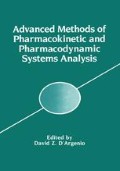Abstract
In contrast to other mathematical concepts used in pharmacokinetics the theory of residence time distributions (RTDs) is independent of a detailed structural model or a particular curve model. In view of the fact that interpretations of RTDs have been mostly based on compartmental models (e. g., [1, 2]), the following shortcomings of this class of structural models should be noted: 1) there is no a priori reason for the existence of homogeneous compartments. The assumption that all elementary subsystems are characterized by exponentially distributed transit times restricts the generality of the approach; 2) the definition of a sampling compartment from which elimination occurs does not allow for a differentiation between sampling upstream or downstream of the elimination site, which leads to inconsistencies in the definition of the volume of distribution, V ss [3].
Access this chapter
Tax calculation will be finalised at checkout
Purchases are for personal use only
Preview
Unable to display preview. Download preview PDF.
References
J. H. Matis, T. E. Wehrly, and C. M. Metzler. On some stochastic formulations and related statistical moments of pharmacokinetic models. J. Pharmacokin. Biopharm. 11:77–92 (1983).
S. L. Beal. Some clarifications regarding moments of residence times with pharmacokinetic models. J. Pharmacokin. Biopharm. 15:75–92 (1987).
M. Weiss. Nonidentity of the steady-state volumes of distribution of the eliminating and noneliminating system. J. Pharm. Sci. (in press).
R. E. Barlow and F. Proschan. Statistical Theory of Reliability and Life Testing, Holt, Rinehart and Winston, New York, 1975.
W. Feller. An Introduction to Probability Theory and its Applications, Vol. 2, Wiley, New York, 1966.
M. Brown. Approximating IMRL distributions by exponential distributions, with applications to first passage times. Ann. Probab. 11:419–427 (1983).
P. Embrechts. A property of the generalized inverse Gaussian distribution with some applications. J. Appl. Probab. 20:537–544 (1983).
T. K. Henthorn, M. J. Avram, and T. C. Krejcie. Intravascular mixing and drug distribution: The concurrent disposition of thiopental and indocyanine green. Clin. Pharmacol. Ther. 45:56–65 (1989).
M. Weiss. Generalizations in linear pharmacokinetics using properties of certain classes of residence time distributions. I. Log-convex drug disposition curves. J. Pharmacokin. Biopharm. 14:635–657 (1986).
M. Weiss. Generalizations in linear pharmacokinetics using properties of certain classes of residence time distributions. II. Log-concave concentration-time curves following oral administration. J. Pharmacokin. Biopharm. 15:57–74 (1987).
M. Brown and G. Ge. Exponential approximations for two classes of aging distributions. Ann. Probab. 12:869–875 (1984).
J. Keilson. Markov Chain Models-Rarity and Exponentiality, Springer-Verlag, New York, 1979.
M. Weiss. Use of gamma distributed residence times in pharmacokinetics. Eur. J. Clin. Pharmacol. 25:695–702 (1983).
M. E. Wise. Negative power functions of time in pharmacokinetics and their implications. J. Pharmacokin. Biopharm. 13:309–346 (1985).
G. T. Tucker, P. R. Jackson, G. C. A. Storey, and D. W. Holt. Amiodarone disposition: Polyexponential, power and gamma functions. Eur. J. Clin. Pharmacol. 26:655–856 (1984).
V. K. Piotrovskii. Pharmacokinetic stochastic model with Weibull-distributed residence times of drug molecules in the body. Eur. J. Clin. Pharmacol. 32:515–523 (1987).
S. Riegelman and P. Collier. The application of statistical moment theory to the evaluation of in vivo dissolution time and absorption time. J. Pharmacokin. Biopharm. 8:509–534 (1980).
J. M. van Rossum and C. A. M. van Ginneken. Pharmacokinetic system dynamics. In E. Gladtke and H. Heimann (eds.), Pharmacokinetics, Fischer, Stuttgart, 1980, pp. 53–73.
B. Jorgensen. Statistical properties of the generalized inverse Gaussian distribution. Lecture Notes in Statistics, Vol. 9, Springer-Verlag, New York, 1982.
M. S. Roberts, J. D. Donaldson, and M. Rowland. Models of hepatic elimination: Comparison of stochastic models to describe residence time distributions and to predict the influence of drug distribution, enzyme heterogeneity, and systemic recycling of hepatic elimination. J. Pharmacokin. Biopharm. 16:41–83 (1988).
D. R. Cox. Renewal Theory, Methuen, London, 1962.
M. Weiss. Theorems on log-convex disposition curves in drug and tracer kinetics. J. Theor. Biol. 116:355–368 (1985).
M. Brown. Bounds, inequalities, and monotonicity properties for some specialized renewal processes. Ann. Probab. 8:227–240 (1980).
M. Weiss and K. S. Pang. The dynamics of drug distribution as assessed by the second and third curve moments. Eur. J. Pharmacol. 183:611–622 (1990).
M. Brown. Further monotonicity properties for specialized renewal processes. Ann. Probab. 9:891–895 (1981).
M. Weiss. A note on the role of generalized inverse Gaussian distributions of circulatory transit times in pharmacokinetics. J. Math. Biol. 18:95–102 (1984).
M. Weiss. Moments of physiological transit time distributions and the time course of drug disposition in the body. J. Math. Biol. 15:305–318 (1982).
M. Weiss. Washout time versus mean residence time. Pharmazie 43:126–127 (1988).
M. Weiss. Model-independent assessment of accumulation kinetics based on moments of drug disposition curves. Eur. J. Clin. Pharmacol. 27:355–359 (1984).
J. M. van Rossum, J. E. G. M. de Bie, G. van Lingen, and H. W. A. Teeuwen. Pharmacokinetics from a dynamical systems point of view. J. Pharmacokin. Biopharm. 17:365–392 (1989).
Author information
Authors and Affiliations
Editor information
Editors and Affiliations
Rights and permissions
Copyright information
© 1991 Springer Science+Business Media New York
About this chapter
Cite this chapter
Weiss, M. (1991). Residence Time Distributions in Pharmacokinetics: Behavioral and Structural Models. In: D’Argenio, D.Z. (eds) Advanced Methods of Pharmacokinetic and Pharmacodynamic Systems Analysis. Springer, Boston, MA. https://doi.org/10.1007/978-1-4757-9021-4_9
Download citation
DOI: https://doi.org/10.1007/978-1-4757-9021-4_9
Publisher Name: Springer, Boston, MA
Print ISBN: 978-1-4757-9023-8
Online ISBN: 978-1-4757-9021-4
eBook Packages: Springer Book Archive

